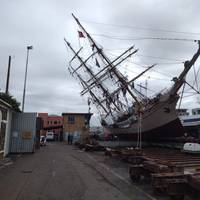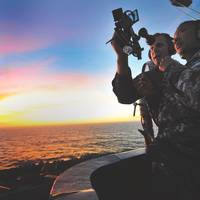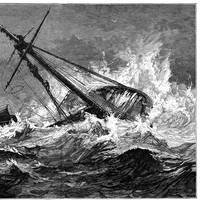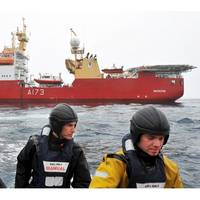Tall Ship Topples Over in Drydock

A 112-year-old tall ship has toppled over during a drydock maintenance period in South Africa.The Netherlands-registered Europa fell over during an attempt to transfer the steel-hulled barque back into the water from drydock at a Cape Town ship repair facility, leaving one crewmember with minor injuries."The injured sailor is receiving the necessary medical care and is doing well, given the circumstances," the ship's operator Bark Europa said. "He is currently in stable condition…
St Helena Line Seeks Buyer for Vessel
St Helena Line has announced that it is to withdraw the Passenger Cargo Royal Mail Ship St Helena from service in February 2018 and has appointed London ship broker CW Kellock & Co Ltd to handle her sale. Operated by St Helena Line Ltd (SHL) on behalf of the St Helena Government (SHG), the RMS has been part of the Island’s history for over quarter of a century and provided the sole regular means of access to the Island, a remote UK Overseas Territory located 1200 miles off the West coast of Africa in the South Atlantic. She was built in the UK in 1990 specifically for the St Helena route. At 6,767 gross tonnes, she can accommodate 156 passengers in 56 cabins, together with a cargo capacity of 3750 cbm bale, and 92 teu (of which 17 reefer). She is staffed by 56 officers and crew.
Automated Skill Erosion

The increasing automation of vessels is causing some mariners to lose basic maritime skills. During dinner on June 10, 1995, the last night before the cruise ship Royal Majesty was due to arrive in Boston from its voyage to Bermuda, the master bragged to the passengers at his table that his ship could never run aground because it had all the latest electronic equipment, including a navigation system that integrated the GPS signals and other information. At 2225 that night the ship grounded on the Rose and Crown Shoal near Nantucket. It was 17 miles west of its planned trackline.
Avoiding the Edges of the Sea

Mariners do best when they avoid the edges of the sea – the shoals, rocks, and other hard spots. Coming into contact with the edges of the sea at other than a slow walking speed can ruin an otherwise pleasant voyage. Unfortunately, though, vessels have been making hard contact with the edges since Noah’s Ark grounded on Mount Ararat, rendering the Ark unseaworthy. For a while, it was thought that the leadline would reduce groundings, but one can’t be swinging the leadline constantly. Lighthouses were another early means of identifying hard spots by means other than direct contact.
Offshore Survey of World's Most Remote Inhabited Territory

British navy ice patrol ship 'HMS Protector' conducts the first systematic survey since the 1970's of waters off Tristan da Cunha in the South Atlantic. In the first survey of the area to be conducted using modern techniques, HMS Protector used her motorboat and onboard systems to make a multibeam echo sounder survey of the Edinburgh Anchorages. The territory is the most remote inhabited archipelago in the world, lying 1,750 miles (2,816km) from the nearest land, South Africa, and 2,088 miles (3,360km) from South America.
RIB DIRECTORY
VT Halmatic has delivered an Arctic 24 rigid inflatable boat (RIB) to the island of Tristan da Cunha. Located in the South Atlantic, approximately 1,740 miles west of Cape Town, Tristan da Cunha is acknowledged as the world's most remote inhabited island. The island supports a thriving community concentrating on fishing and agriculture and the new RIB joins an existing VT Halmatic Pacific 38 RIB. The new Arctic 24 will be used as an additional fisheries patrol boat and fast rescue craft as well as search and rescue and policing duties. Based on a deep V hull form, the Arctic 24 is known as an off-shore RIB that is available in the market place and is capable of operating in the extreme sea states found around the island.
RIBS Roundup
Moose Boats won two contracts from the U.S. Navy to build six more Moose 340C Catamaran Patrol Boats. The contract totals approximately $2.9 million, and the first boat is scheduled to be delivered in January 2005. The Moose 340C is a 36.5-ft. 380 hp turbo diesels and is propelled by Hamilton 292 water jets. These vessels will be assigned to stations in San Diego, Calif. If required, the boat can be deployed at speeds over 34 knots with armament including 50 caliber and M60 machine guns. Moose Boats will demonstrate the 340C Patrol Boat in the water at MACC 2004. Willard Marine's 36 ft. Enforcer RIB features a removable cabin. These all-weather craft, complete with heating and air-conditioning, can be used for ship's boats and for 24-hour patrol.
Titan Refloats and Scuttles a Semi-Submersible Platform
Atlantic Ocean. to Singapore for rebuilding. Titan did a preliminary survey at the end of October, and determined that the platform could be repaired and refloated. A tender for removal was issued in November and Titan was selected as wreck removal contractor. In December a "No-Cure, No-Pay" contract was agreed to with the owner and underwriters of the A Turtle. Titan's salvage team arrived at the site of the casualty Dec. 22, after a 1,743-mile-trip on the chartered vessel Kelso. The remainder of the 20 person Titan salvage team arrived 7 days later on the chartered tug De Hong. grounding and subsequent extreme weather. December. during the first week of February. topside of the rig and discarding them at an approved disposal site. away. at Trypot Bay. the A Turtle from the reef on Feb.







